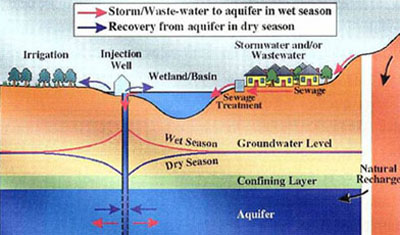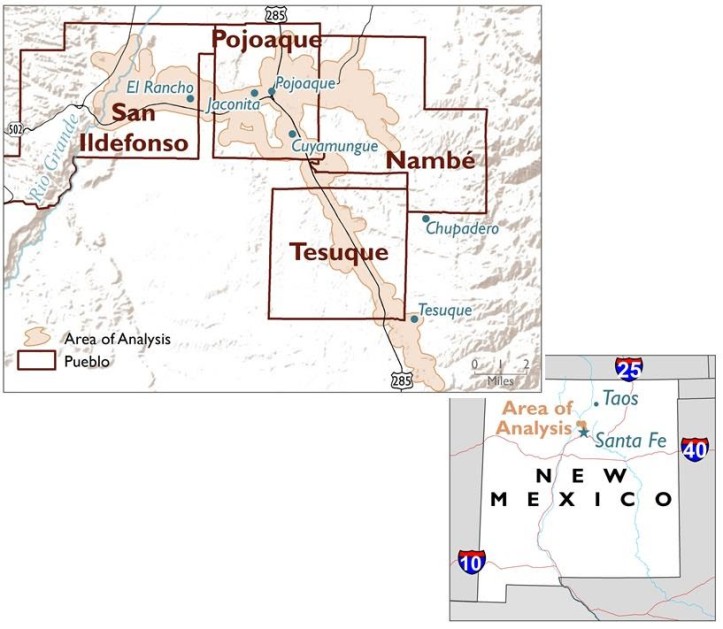By KAY MATTHEWS
I made my semi-annual call to John Utton, Santa Fe County Attorney, to ask when the county and Department of the Interior plan to file their application to transfer Top of the World (TOW) water, in northern Taos County, to the Pojoaque Valley as part of the Aamodt Settlement. Before he called me back, one of the 650 people who filed 792 objections to the settlement speculated that all the lawyers are too busy responding to these objections to have time to jump into what will inevitably lead to more legal wrangling once the application is filed.
When I did finally speak with Utton he told me that while he still doesn’t have a confirmed time frame he anticipates the joint application, by Santa Fe County and the Department of the Interior, will be filed in the next few months.
In order to fulfill the terms of the settlement, the county and Interior must supply 4,000 acre feet of water per year (afy) to Pojoaque, San Ildefonso, Tesuque, and Nambe pueblo and non-pueblo residents in the Pojoaque Valley via a Regional Water System (RWS). The Bureau of Reclamation (BOR) is currently drafting an Environmental Impact Statement (EIS) for the RWS that will divert Rio Grande surface water at San Ildefonso Pueblo, treat it, store it, transmit it, and deliver it throughout the basin.
The water will be taken from the Rio Grande by either diverting the surface water into a side intake structure or by collecting groundwater that is hydrologically connected to the river through the use of horizontal collector wells or infiltration gallery. This idea of a collector was first put forward back in the late 1990s when Santa Fe County proposed that a Ranney Collector be used to divert TOW water rights to the Buckman Well Field to offset groundwater pumping and allow for future development.
The pueblos’ share of the water rights, 2,500 afy, are from several sources: 1,079 afy of San Juan-Chama project water; 1,141 afy from Top of the World Farm in northern Taos County; and 302 afy Nambe reserved water rights. According to the Pojoaque Basin Regional Water System EIS web site, these 1,141 afy of water rights from TOW, originally bought by Santa Fe County, have been purchased by the Bureau of Indian Affairs (within the Department of the Interior). The County has reserved up to 1,500 afy for non-pueblo residents from TOW and domestic well transfers into the water system.

As I reported in April of 2013, it looked like the storage system for the RWS was going to be a system of underground aquifers called Aquifer Storage and Recovery (ASR). In this system water is injected into underground aquifers for storage and then recovered when needed, a concept that has become more common in the last 10 to 15 years, largely because of its economic benefits—as opposed to the capital outlay for a reservoir or storage tanks—and because of already depleted aquifers that the injected water can help restore. A mechanism for storing water has to be in place, as the RWS system will be completely dependent on surface water, with no back-up groundwater utility as in the Santa Fe diversion system and no dams to regulate releases for the TOW water. But the BOR recently sent out letters to Valley residents stating that the EIS is going to have to develop other alternatives for water storage because ARS test wells have failed. Apparently the area geology has proved inadequate to effectively contain the water in the test wells, so it’s back to the drawing board.
A new organization called Northern New Mexicans Protecting Land, Water, and Rights that formed in 2014 has been particularly active in its opposition to the Aamodt Settlement. The group coalesced over controversies between county residents and San Ildefonso Pueblo concerning road and utility easements in the Valley, which also raised questions about easements for the RWS that have yet to be determined. Members of the group have been attending interim state legislative committees, particularly Water and Natural Resources, to ask questions about not only the easements and rights of way but the rising cost of the state’s share of the RWS, from $49.5 million in 2006 dollars to what some are saying is closer to $80 million. As I reported previously in La Jicarita, Nambe State Representative Carl Trujillo joined with two other legislators from the Aztec area to file suit against the State Engineer and Interstate Stream Commission asking the State Supreme Court to order a review of the Navajo Water Rights Settlement. The suit claims that former Governor Bill Richardson pushed the settlement through his office in 2010 without getting authorization from the legislature to fund the state’s part of the total $800 million price tag. Objectors to the Aamodt Settlement are asking the same kinds of questions about their settlement.
The deadline for completion of the EIS is September 15, 2017. The deadline for completion of the RWS is June 30, 2024. The deadline for the response to all the objectors (the court sends out “Orders to Show Cause” to the “defendants,” i.e. water rights owners, who must state their reasons for objecting) is the middle of January, 2015. I read through some of these objections, and the city, county, and state’s response, “Joint Opening Brief,” that Utton sent me. The state classifies the objections into 26 categories and then reduces those into six general categories:
- A) Due Process / Notice / Equal Protection. Many of the objectors claim that the “Orders to Show Cause” were not sent certified mail, resulting in people being deprived of due process.
- B) Federal law / Indian water rights / Rights of Pueblos. These objections question federal versus state jurisdiction over pueblo water rights and how present and future Indian water rights were determined.
- C) The State had authority to enter into the Settlement Agreement, which is consistent with State law. Many objectors claim the settlement exceeds state authority and that the state legislature must approve funding for the settlement.
- D) Domestic wells. Objectors claim that the settlement constitutes a “taking” of domestic well rights and that the indoor use restrictions are unlawful.
- E) Treaty of Guadalupe Hidalgo and Acequia rights. Objectors believe that water should be managed under the repartimiento or water sharing system established under Mexican and Spanish sovereignty.
- F) Settlement Implementation. Many of the details of the settlement remain undecided: representation on the Regional Water Authority; the Joint Powers agreement; easements for the RWS; and funding of the RWS.
While the state, county, and city address these objection categories in the 68-page Joint Brief, the basic answer is: “As detailed below, none of the objectors has identified how they will be injured by the Settlement Agreement or the entry of the proposed Partial Final Judgment and Decree in a legally cognizable way. All objections should be dismissed or overruled.”
It seems likely that those objectors who don’t accept the District Court’s decision, and who have the means to pay for legal representation, are going to take their case to the Appellant Court in Denver.
When the county and BIA file to transfer the TOW water rights, any number of groups, governments (Taos County?), and individuals will file protests with the Office of the State Engineer, which is already backlogged with numerous other protests, several of which pertain to the other northern New Mexico settlement, the Taos Pueblo Water Rights adjudication, the Abeyta Settlement. Many of these protestants will argue that groundwater from the TOW area the county and feds claim will migrate to the Rio Grande to supply surface water for the RWS is based on a faulty hydrologic model.
The RWS will be one of many straws sucking water from the Rio Grande system, from northern Taos County to the bottom of the watershed in the Lower Rio Grande adjudication, where Texas has already sued New Mexico over failure to deliver Rio Grande Compact Water. Seems to me it’s a fool’s game, but as a lonely protestant to one of the Abeyta transfer applications, I don’t have much influence in the larger scheme of things (I have managed to keep my protest alive despite the attempt to strike me as a protestant, which I will address in a forthcoming article).


Thanks for writing such an excellent article. Yes, Northern New Mexicans Protecting Land, Water, and Rights Inc. continues to work towards a reasonable settlement.
The failure of the ARS to fulfill the storage needs has become some what catastrophic because now the RWS must store all of the water in above ground tanks. At about $1.00/gallon to construct above ground storage, this will significantly increase the cost of the RWS especially when you consider the RWS needs to provide fire protection (2 hr fire flow@ 500 GPM/minute) along the 20 miles of water main from San Ildefonso Pueblo to Bishop Lodge.
The infiltration gallery was strategically located upstream of the Rio Grande Otowi Bridge gauging station because all water that passes through this gauging station is subject to the Texas-New Mexico water compact that is gradually making its way to the US Supreme Court.
We have finally received a copy of the Water Master Rules and Regulations after filing a “IPRA” request with the State. It is so sad our own State Government is denying New Mexicans access to some of the settlement documents that will definitely effect us. In January, we will be meeting with the County and representatives from NNMProtects to begin discussing the contents of the Joint Powers Agreement. These documents are now available on the http://www.nnmprotects.org web site under Aamodt documents.
Right now there are two attorneys, Lorenzo Atencio and Blair Dunn, who are actively representing the defendants in this seemly ridiculous lawsuit.You are correct that we expect this settlement to end up in the 10th Circuit Court of Appeals in Denver.
Dave Neal
VP, NNMProtects
nnmprotects@gmail.com
Other active adjudication cases involving the Office of the State Engineer/ Interstate Stream Commission @ http://www.ose.state.nm.us/Legal/activeCases.php